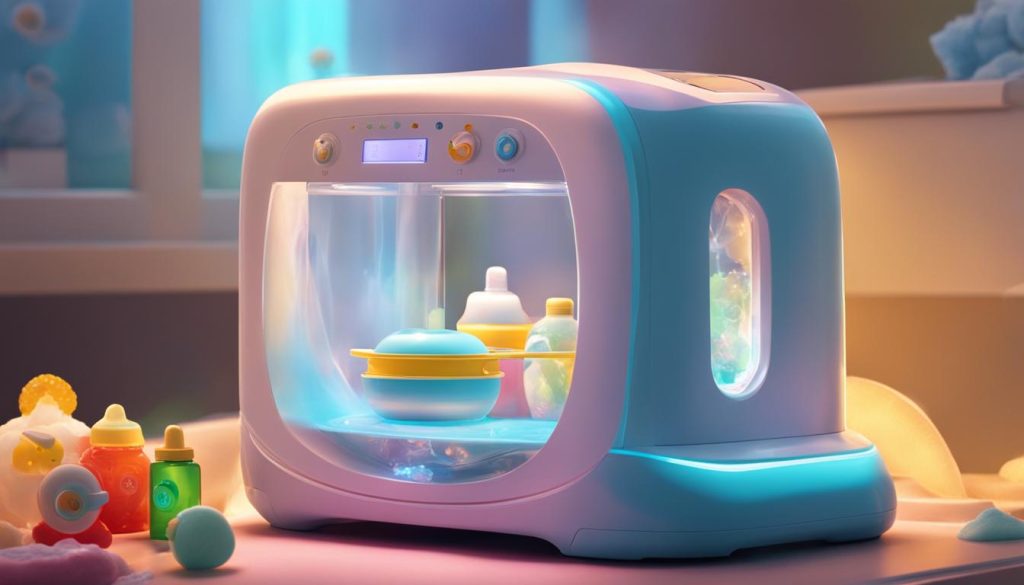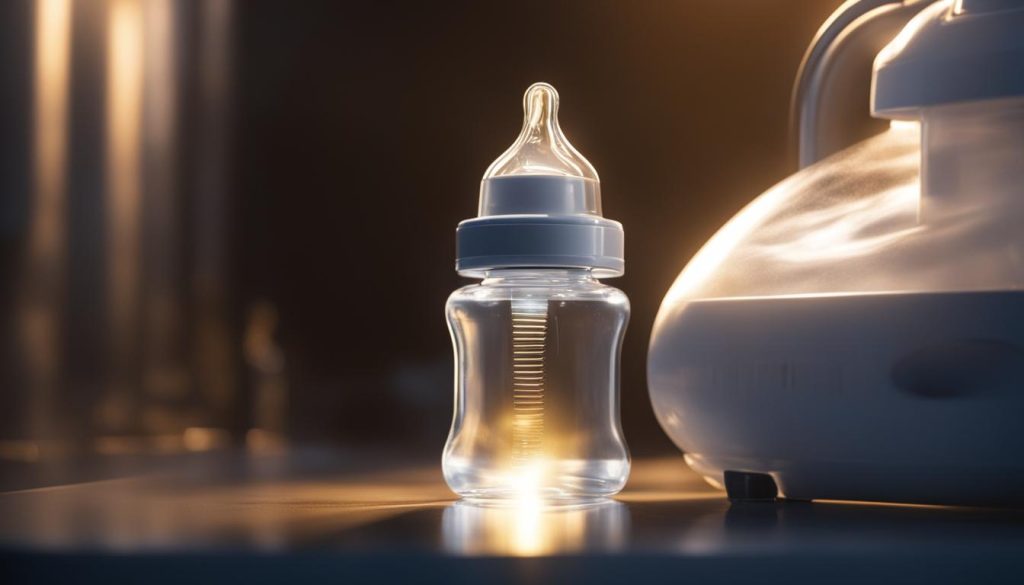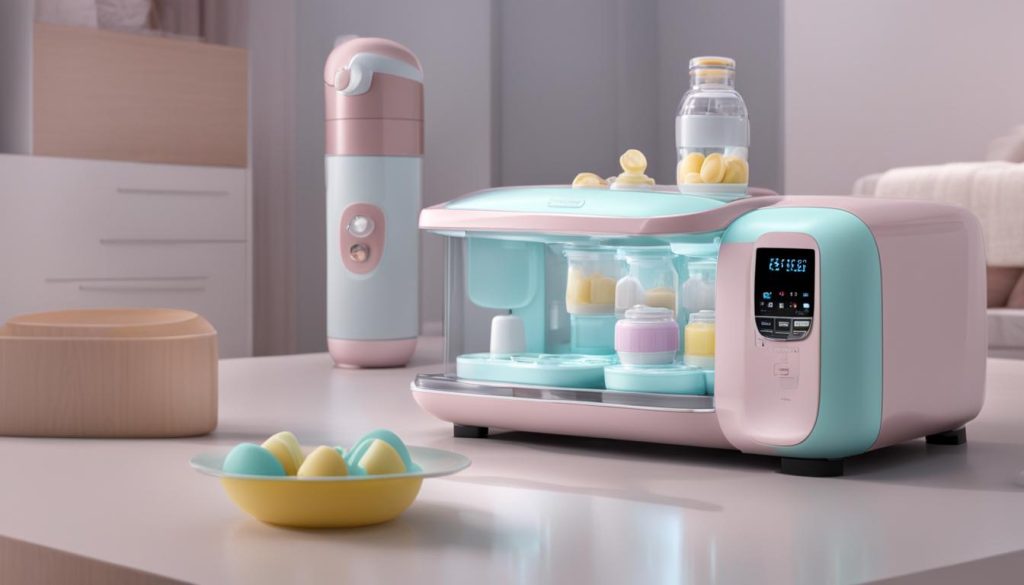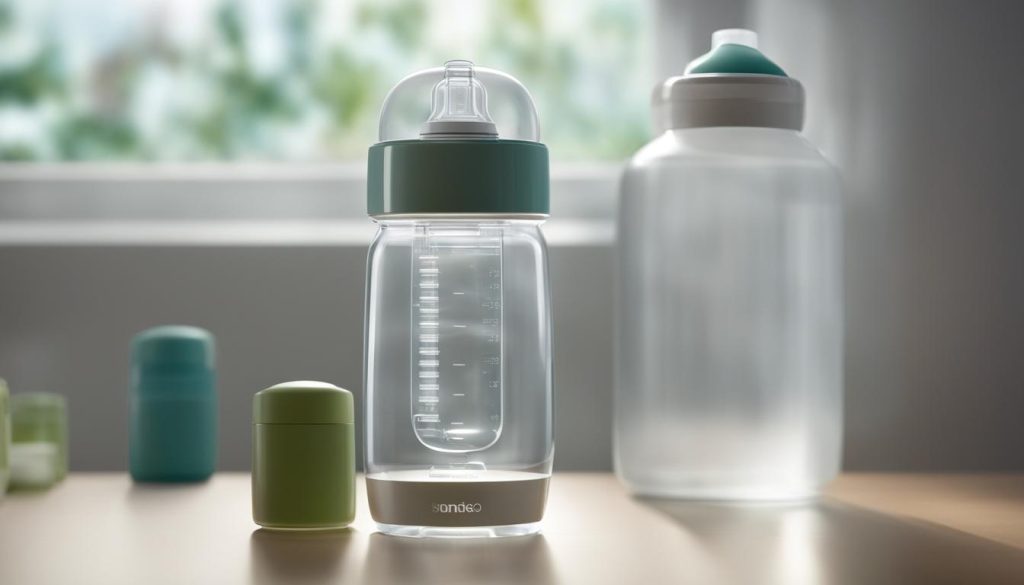Baby sterilizers are crucial for maintaining the health and hygiene of your baby’s items. They help eliminate harmful bacteria and germs that can pose a risk to your baby’s well-being. In the first few months of your baby’s life, when their immune system is still developing, sterilizing baby bottles becomes even more essential. There are various types of baby sterilizers available in the market, each with its own features and benefits. Let’s explore the effectiveness and ease of use of different types of baby sterilizers to help you choose the best one for your baby’s needs.
When and Why Do You Need to Sterilize Your Baby’s Bottles?
Sterilizing baby bottles is an important step in ensuring the health and safety of your little one. But when exactly should you sterilize their bottles, and why is it necessary?
When it comes to the timing of sterilization, it is recommended to do it in the first few months of your baby’s life. This is because newborns have an immature immune system, making them more vulnerable to infections caused by harmful bacteria. Sterilizing their bottles provides an extra layer of protection against these germs and minimizes the risk of your baby falling ill.
So, why is it necessary to sterilize your baby’s bottles? The reason is simple: to eliminate any potential bacteria or contaminants that may be present. By sterilizing the bottles, you can ensure that your baby is consuming milk or formula from a clean and safe container, reducing the risk of infections and keeping them healthy.
It’s important to note that as your baby grows older and their immune system strengthens, daily sterilization may no longer be necessary. However, there are certain circumstances where sterilization should continue, such as if your baby was born prematurely, lives in an area with limited access to clean water, has a weakened immune system, has been sick, or if someone in your household has a contagious illness.
In conclusion, sterilizing your baby’s bottles is crucial for their well-being, especially in the early months of life. By following proper sterilization practices, you can ensure that your baby is consuming milk or formula from a clean and germ-free container. Remember to adjust the frequency of sterilization as your baby grows, and always prioritize their health and safety.
How to Sterilize Baby Bottles Effectively
Properly sterilizing baby bottles is essential to ensure the safety and well-being of your little one. There are several effective methods available, each offering its own advantages. Here, I will guide you through the most common and recommended ways to sterilize baby bottles.
Boiling Method
One of the simplest and most cost-effective methods is boiling the bottles in water. This method requires disassembling the bottles and placing them in a pot with enough water to cover all the parts. Boil the water for at least 5 minutes, then allow it to cool before removing the sterilized bottles. It is important to note that this method may cause wear and tear on the bottles over time, so regular inspection and replacement may be necessary.
Microwave Sterilizer
If convenience is a priority for you, consider investing in a microwave sterilizer specifically designed for baby bottles. These sterilizers use steam to kill bacteria and are quick and easy to use. Simply add water to the sterilizer, place the disassembled bottles inside, and follow the manufacturer’s instructions for the appropriate microwave setting. Remember to allow the bottles to cool before handling.
Cold-Sterilization Chemicals
An alternative option is to use cold-sterilization chemicals, which are available in tablet or liquid form. This method involves soaking the bottles in a solution containing the sterilizing agent for the recommended amount of time. While this method is effective, it requires careful rinsing of the bottles afterward to remove any residual chemicals.
Regardless of the sterilization method you choose, always follow the manufacturer’s instructions for proper use and maintenance of your chosen sterilizer. Regular cleaning and periodic descaling are essential to ensure the longevity and effectiveness of the sterilization process. By taking these steps, you can keep your baby’s bottles germ-free and provide them with a safe feeding experience.
Tips for Properly Sterilizing Baby Bottles
When it comes to sterilizing baby bottles, following the proper techniques is essential to ensure the health and safety of your little one. Here are some valuable tips and best practices to help you effectively sterilize your baby’s bottles:
1. Start with Clean Hands
Before handling the baby bottles, it is crucial to wash your hands thoroughly with warm soapy water. Clean hands will minimize the risk of transferring any additional germs or bacteria to the bottles during the sterilization process.
2. Disassemble and Rinse
Prior to sterilization, completely disassemble the bottles, including the nipples and other parts. Rinse them under warm running water to remove any milk residue. It is not necessary to wash the bottles with soap before sterilization, as the sterilization process itself is effective in killing 99.9% of germs.
3. Choose the Right Sterilization Method
There are various methods available for sterilizing baby bottles, such as boiling, microwaving, cold-sterilization chemicals, and electric sterilizers. Choose the method that suits your needs and follow the manufacturer’s instructions for proper sterilization. For example, boiling the bottles in water for at least 5 minutes is a common and effective method.
4. Sterilize Once a Day
To maintain the cleanliness of the bottles, it is recommended to sterilize them at least once a day, even if you are not using all the bottles within that day. This practice ensures that the bottles remain free from any potential bacteria or contaminants.
By following these tips and best practices for baby bottle sterilization, you can provide your little one with a safe and hygienic feeding environment.
| Sterilization Method | Advantages | Disadvantages |
|---|---|---|
| Boiling | – Widely accessible and cost-effective – Kills germs effectively |
– Requires supervision and waiting time – May cause wear and tear on bottles over time |
| Microwaving | – Quick and convenient – Sterilizes effectively with steam |
– Requires special microwave sterilizer – Some bottles may not fit |
| Cold-Sterilization Chemicals | – No heat required – Portable and can be used on-the-go |
– Can leave a chemical residue on bottles – Requires purchase of sterilizing solution |
| Electric Sterilizers | – User-friendly – Sterilizes effectively with steam |
– Requires electricity and specific equipment – Higher cost compared to other methods |
Other Essential Baby Sterilizer Options
When it comes to keeping your baby’s items germ-free, there are a variety of sterilizer options available on the market. In addition to traditional methods of sterilizing baby bottles, such as boiling or using electric steam sterilizers, there are other options that offer convenience and additional features.
One such option is a portable baby sterilizer. These compact and travel-friendly sterilizers allow you to sterilize bottles on the go, making them ideal for families who are constantly on the move. Portable baby sterilizers use various methods, including steam and UV light, to kill bacteria and ensure your baby’s bottles are clean and safe to use.
Another innovative option is a UV baby sterilizer. These sterilizers use UV-C lamps to kill viruses and bacteria without the need for water or chemicals. UV sterilizers are quick and efficient, providing a germ-free environment for your baby’s bottles. They are especially useful for parents who want a chemical-free sterilization method.
If you prefer a more traditional approach, steam baby sterilizers may be the right choice for you. These sterilizers use steam to effectively kill germs and bacteria on your baby’s bottles. Some steam sterilizers also have added features like drying functions, which can be convenient for busy parents.
Last but not least, microwave baby sterilizers offer a quick and efficient way to sterilize bottles. These sterilizers are specifically designed for use in the microwave and provide effective sterilization within minutes. Microwave sterilizers are often compact, making them ideal for small kitchens or for families with limited counter space.
| Sterilizer Type | Description |
|---|---|
| Portable Baby Sterilizer | Compact and travel-friendly sterilizers that allow you to sterilize bottles on the go using steam or UV light. |
| UV Baby Sterilizer | Sterilizers that use UV-C lamps to kill viruses and bacteria without the need for water or chemicals. |
| Steam Baby Sterilizer | Sterilizers that use steam to effectively kill germs and bacteria on baby bottles, with some models offering drying functions. |
| Microwave Baby Sterilizer | Sterilizers designed for use in the microwave, providing quick and efficient sterilization within minutes. |
The Benefits of Baby Bottle Sterilizers
Baby bottle sterilizers offer numerous benefits for parents. They provide peace of mind by ensuring that your baby’s bottles are free from harmful bacteria and germs, reducing the risk of infections. With the advantages of using bottle sterilizers, parents can have confidence in the cleanliness of their baby’s feeding equipment.
Sterilizers are also convenient and save time compared to washing bottles by hand. They offer a quick and efficient way to sterilize multiple bottles at once, allowing parents to spend more time with their baby. By choosing a reliable sterilizer, parents can streamline their daily routine and focus on their baby’s well-being.
In addition to their germ-killing capabilities, baby bottle sterilizers help extend the lifespan of baby bottles. By keeping the bottles clean and preventing the buildup of residue, sterilizers help maintain the quality and longevity of the bottles. This can be particularly beneficial for parents who invest in high-quality bottles and want to ensure they last through multiple uses.
“Baby bottle sterilizers provide convenience, peace of mind, and help extend the lifespan of baby bottles. They are a valuable tool for maintaining the health and hygiene of your baby’s feeding equipment.”
Furthermore, the wide range of sterilization methods available allows parents to choose the one that fits their lifestyle and preferences. Whether it’s boiling, using microwave sterilizers, cold-sterilization chemicals, or electric steam sterilizers, there is a sterilization method to suit every need. Some sterilizers even offer additional features, such as drying functions, which make the process even more efficient and convenient.
Overall, baby bottle sterilizers are a worthwhile investment for any parent. The benefits they offer, including peace of mind, convenience, and extended bottle lifespan, make them an essential item for maintaining your baby’s health and hygiene.
Top-Rated Baby Bottle Sterilizers
When it comes to ensuring the utmost cleanliness and hygiene for your baby’s bottles, choosing the best baby sterilizer is essential. There are several top-rated options available in the market that offer effective and convenient sterilization methods.
One popular choice is an electric baby sterilizer, such as the Philips Avent Electric Steam Sterilizer. This device utilizes steam to kill bacteria, providing a quick and efficient sterilization process. It can sterilize multiple bottles at once, saving you time and effort.
If you’re looking for a versatile option, a bottle warmer and sterilizer combo might be the perfect solution. The Dr. Brown’s Deluxe Baby Bottle Warmer and the Tommee Tippee Closer to Nature Electric Baby Bottle and Food Warmer not only sterilize bottles effectively but also warm them to the desired temperature. These devices offer convenience and functionality in one.
When selecting the best baby sterilizer for your needs, consider factors such as effectiveness, ease of use, and your budget. These top-rated options have been trusted by parents and provide the peace of mind you need when it comes to ensuring your baby’s bottles are clean and germ-free.
FAQ
When is it necessary to sterilize baby bottles?
It is recommended to sterilize baby bottles, especially in the first few months of your baby’s life. This is because newborns have an immature immune system, making them more susceptible to infections caused by harmful bacteria. Sterilizing bottles provides an extra layer of protection against these germs. However, as your baby grows older and their immune system strengthens, daily sterilization may no longer be necessary. It is generally advised to continue sterilizing bottles if your baby was born prematurely, lives in an area with limited access to clean water, has a weakened immune system, has been sick, or if someone in your household has a contagious illness. Sterilizing baby bottles before their first use is also recommended to ensure they are free from any bacteria or contaminants.
What are the effective methods to sterilize baby bottles?
There are several effective methods to sterilize baby bottles, depending on your preference and available resources. One common method is boiling the bottles in water. Simply disassemble the bottles and place them in a pot with enough water to cover all the parts. Boil the water for at least 5 minutes, then allow it to cool before removing the sterilized bottles. Another option is to use a microwave sterilizer specifically designed for baby bottles. These sterilizers use steam to kill bacteria and are quick and convenient to use. Alternatively, you can opt for cold-sterilization chemicals or the sanitizing setting in your dishwasher to sterilize the bottles. Electric sterilizers are also available, which use steam to kill germs. Choose the method that suits your needs and follow the manufacturer’s instructions for proper sterilization.
Do I need to wash baby bottles before sterilizing them?
Before sterilizing baby bottles, ensure that you wash your hands thoroughly with warm soapy water. It is important to completely disassemble the bottles, including nipples and other parts, and rinse them under warm running water to remove any milk residue. Prior washing with soap is not necessary before sterilization, as the sterilization process itself effectively kills 99.9% of germs. It is recommended to sterilize baby bottles once per day, even if you are not using them all in one day, to maintain their cleanliness. Store the sterilized bottles in a protected area, such as a closed kitchen cabinet, and assemble the bottles just before use to minimize the risk of contamination.
What are the different types of baby sterilizers available?
In addition to traditional methods of sterilizing baby bottles, there are other options available that offer convenience and additional features. Portable baby sterilizers are compact and travel-friendly, allowing you to sterilize bottles on the go. UV baby sterilizers use UV-C lamps to kill viruses and bacteria without the need for water or chemicals. Steam baby sterilizers utilize steam to effectively sterilize bottles, often with added features like drying functions. Microwave baby sterilizers are specifically designed for use in the microwave and provide quick and efficient sterilization. Each of these options comes with its own advantages and can be chosen based on your specific needs and preferences.
What are the benefits of using baby bottle sterilizers?
Baby bottle sterilizers offer numerous benefits for parents. They provide peace of mind by ensuring that your baby’s bottles are free from harmful bacteria and germs, reducing the risk of infections. Sterilizers are convenient and save time compared to washing bottles by hand. They also help extend the lifespan of baby bottles by keeping them clean and preventing the buildup of residue. With various sterilization methods available, parents can choose the one that fits their lifestyle and preferences. Additionally, some sterilizers offer additional features such as drying functions, making the process even more efficient and convenient.
Which are the top-rated baby bottle sterilizers?
When it comes to choosing a baby bottle sterilizer, there are several top-rated options available. Electric baby sterilizers, such as the Philips Avent Electric Steam Sterilizer and the Baby Brezza Baby Bottle Sterilizer, are popular choices due to their effectiveness and ease of use. These sterilizers use steam to kill bacteria and can sterilize multiple bottles at once. Another option is a bottle warmer and sterilizer combo, like the Dr. Brown’s Deluxe Baby Bottle Warmer and the Tommee Tippee Closer to Nature Electric Baby Bottle and Food Warmer. These devices not only sterilize bottles but also warm them to the desired temperature. Consider your specific needs and budget when choosing the best baby sterilizer for you and your baby.





